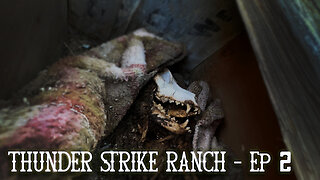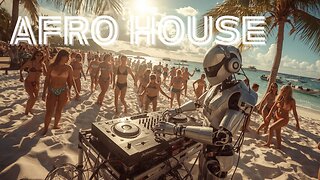Premium Only Content

A Drive Thru The KU Campus
This is a drive I took in my Mazda Miata thru the University of Kansas campus, after attending the KU Jayhawks victory parade earlier. I begin at the parking lot in front of Green Hall, which use to be The Burge Union up until 2016. Then I travel up Naismith Drive to the top of the hill, and proceed to circle around the Chi Omega Fountain, on down West Campus Road by JRP Hall, then back around the Chi Omega Fountain, and finally down Jayhawk Boulevard.
For some reason my FeiyuTech camera shifted to slo-mo mode for this footage, there I had to speed it up 4 times in post production to get back to average speed. And unfortunately no audio is recorded when in slo-mo mode.
This was shot on Sunday April 10th, 2022. It was a pleasantly gorgeous day out, partly cloudy with temperatures reaching 80°, but was also quite breezy, with gusts of winds reaching 50 MPH.
Wikipedia on KU:
The University of Kansas (KU) is a public research university with its main campus in Lawrence, Kansas, United States, and several satellite campuses, research and educational centers, medical centers, and classes across the state of Kansas.[13] Two branch campuses are in the Kansas City metropolitan area on the Kansas side: the university's medical school and hospital in Kansas City, the Edwards Campus in Overland Park, a hospital and research center in the state's capital of Topeka, and a hospital and research center in Hays. There are also educational and research sites in Garden City, Hays, Leavenworth, Parsons, and Topeka, an agricultural education center in rural north Douglas County, and branches of the medical school in Salina and Wichita. The university is a member of the Association of American Universities and is classified among "R1: Doctoral Universities – Very high research activity".[14]
Founded March 21, 1865, the university was opened in 1866, under a charter granted by the Kansas State Legislature in 1864[15] and legislation passed in 1863 under the State Constitution, which was adopted two years after the 1861 admission of the former Kansas Territory as the 34th state into the Union. Disputes over Kansas' establishment as a free or slaveholding state prior to admission to the union prompted an internal civil war known as "Bleeding Kansas" during the 1850s.[16]
Enrollment at the Lawrence and Edwards campuses was 23,958 students in fall 2021; an additional 3,727 students were enrolled at the KU Medical Center (KUMC) for an enrollment of 27,685 [17] students across the three campuses. The university overall (including KUMC) employed 4,776 faculty members (faculty, faculty administrators, graduate student employees and librarians) in fall 2021.[18]
Kansas's athletic teams compete in NCAA Division I sports as the Jayhawks, as members of the Big 12 Conference. They field 16 varsity sports, as well as club-level sports for ice hockey, rugby, and men's volleyball.
History: On February 20, 1863, Kansas Governor Thomas Carney signed into law a bill creating the state university in Lawrence.[19] The law was conditioned upon a gift from Lawrence of a $15,000 endowment fund and a site for the university, in or near the town, of not less than forty acres (16 ha) of land.[20] If Lawrence failed to meet these conditions, Emporia instead of Lawrence would get the university.
The site selected for the university was a hill known as Hogback Ridge (later known as Mount Oread), which was privately donated by Charles L. Robinson, Republican governor of the state of Kansas from 1861 to 1863, and one of the original settlers of Lawrence, Kansas. Robinson and his wife Sara bestowed the 40-acre (16 ha) site to the State of Kansas in exchange for land elsewhere.[20] The philanthropist Amos Adams Lawrence donated $10,000 of the necessary endowment fund, and the citizens of Lawrence raised the remaining money themselves via private donations.[20] On November 2, 1863, Governor Carney announced Lawrence had met the conditions to get the state university, and the following year the university was officially organized.[15] The school's Board of Regents held its first meeting in March 1865, which is the event that KU dates its founding from.[2][21] Work on the first college building began later that year.[15] The school opened for classes on September 12, 1866, and the first class graduated in 1873.[15] According to William L. Burdick, the first degree awarded by the university was a Doctor of Divinity, bestowed upon noted abolitionist preacher Richard Cordley.[22]
During World War II, Kansas was one of 131 colleges and universities nationally that took part in the V-12 Navy College Training Program, which offered students a path to a Navy commission.
Famous landmarks and structures:
KU is home to the Robert J. Dole Institute of Politics, the Beach Center on Disability, Lied Center of Kansas and radio stations KJHK, 90.7 FM, and KANU, 91.5 FM. The university is also host to several significant museums. These include the University of Kansas Natural History Museum, founded in 1927, which contains important collections in ornithology, vertebrate paleontology, and entomology; and the Spencer Museum of Art, founded in 1928, home to a wide variety of cultural materials from all around the world, with a particular emphasis on American Indian materials. The libraries of the University include Watson Library,[24] Kenneth Spencer Research Library,[25] the Murphy Art and Architecture Library,[26] Thomas Gorton Music & Dance Library,[27] and Anschutz Library.[28] Of athletic note, the university is home to Allen Fieldhouse, which is heralded as one of the greatest basketball arenas in the world, and David Booth Kansas Memorial Stadium, which is the eighth oldest college football stadium in the country.
Academics:
The University of Kansas is a large, state-sponsored university with five campuses. KU is a member of the Association of American Universities (AAU)[41] and is classified among "R1: Doctoral Universities – Very high research activity".[14] KU features the College of Liberal Arts & Sciences, which includes the School of the Arts and the School of Public Affairs & Administration; and the schools of Architecture, Design & Planning; Business; Education; Engineering; Health Professions; Journalism & Mass Communications; Law; Medicine; Music; Nursing; Pharmacy; and Social Welfare. The university offers more than 345 degree programs. In 2017 Johnson County accounted for most of instate enrollment.[42]
In its 2021 report, U.S. News & World Report ranked KU as tied for 124th place among National Universities and tied for 60th place among public universities.[43]
World War II Memorial Campanile
According to the National Science Foundation, KU spent $339 million on research and development in 2018, ranking it 74th in the nation.
Tuition:
Beginning in the 2007–2008 academic year, first-time freshman at KU pay a fixed tuition rate for 48 months according to the Four-Year Tuition Compact passed by the Kansas Board of Regents. For the 2014–15 academic year, tuition was $318 per credit hour for in-state freshman and $828 for out-of-state freshmen. For transfer students, who do not take part in the compact, 2014–15 per-credit-hour tuition was $295 for in-state undergraduates and $785 for out-of-state undergraduates; subject to annual increases. Students enrolled in 6 or more credit hours also paid an annual required campus fee of $888.[56] The schools of architecture, music, arts, business, education, engineering, journalism, law, pharmacy, and social welfare charge additional fees.
As of August 2019, the annual tuition for 30 credit hours for a freshman is estimated by the university to be $10,182, not counting room and board costs.
If you enjoy this video, please click the "plus" button to give me a "Rumble". And comment if you like, and share as well. And you can always subscribe to my channel as well. I'm always coming out with new content on a weekly basis. Have a great day!
-
 43:41
43:41
CarlCrusher
1 hour agoSHOCKING Discovery on the Path of the Skinwalker | Thunder Strike Ranch | Episode 2
-
 30:58
30:58
Solar Groove Muzic
21 hours agoSUMMER AFRO HOUSE BEATS of 2025
44 -
 LIVE
LIVE
RalliedLIVE
6 hours ago $0.92 earnedSpecialist Addicted Man Plays Warzone
207 watching -
 8:38
8:38
WhaddoYouMeme
5 hours ago $0.32 earnedChristians in Iran Are Being Hunted—Here’s Why
4.38K6 -
 LIVE
LIVE
VapinGamers
3 hours ago $0.20 earnedCOD Black Ops 6 with Abnerdagreat, Gunnin and Runnin! - !rumbot
107 watching -
 1:53:32
1:53:32
Glenn Greenwald
4 hours agoWhy Did Zohran Win in NYC? Plus: Gazan Pulitzer Prize Winner Mosab Abu Toha on the Latest Atrocities | SYSTEM UPDATE SHOW #476
168K56 -
 1:41:14
1:41:14
RiftTV/Slightly Offensive
7 hours agoCrowder Takes SHOT at Candace, “Panicans” OBLITERATED? | The Rift | Guests: Hodge Twins
34.1K11 -
 LIVE
LIVE
Spartan
3 hours agoPro Halo Player | Sens Crisis Grind | Ranked Arena, Probably SWTOR at some point
86 watching -
 2:22:56
2:22:56
EnDuEnDo
3 hours ago🚨Variety Stream 🎮 Push to 600 Followers 🚀 Chill Vibes 😎 Content Creator for @SelfMadeGGs & @SMKAcademy
5.56K -
 1:24:04
1:24:04
Playback Request Live
4 hours agoMillennial Meltdown: 2000s Pop Hits & Tabloid Twists
4.76K1